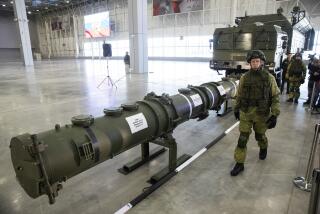Congress Gets Legal Study of ABM Treaty
WASHINGTON — President Reagan forwarded to Congress on Wednesday a new legal study concluding that the 1972 Anti-Ballistic Missile Treaty does not clearly prohibit testing of the Administration’s “Star Wars” defense program, though the pact is ambiguous and the Senate was misled about its meaning before it was ratified 15 years ago.
The 300-page report, prepared by State Department counsel Abraham D. Sofaer, upholds a previous conclusion that Sofaer had reached in October, 1985, and refined last August. Sofaer agreed to reconsider his earlier opinions after a competing legal analysis, prepared by Senate Armed Services Committee Chairman Sam Nunn (D-Ga.), held that the treaty prohibits the sort of “Star Wars” testing the Pentagon wants to undertake.
If Reagan adopts Sofaer’s legal view, it could set the stage for a confrontation with Congress, other members of the North Atlantic Treaty Organization and the Soviet Union. However, Sofaer said the President plans to consult fully with Congress and NATO before deciding whether to go ahead with testing of components for the space-based missile defense system, officially known as the Strategic Defense Initiative.
Sofaer told a press conference that, as a lawyer, his job is to inform the President about “the scope of his discretion.” He said it is up to Reagan to decide how to exercise that discretion.
The 1972 treaty limits the United States and the Soviet Union each to a single anti-ballistic missile system consisting of no more than 100 fixed, land-based interceptor rockets, and it puts severe restrictions on testing of ABM components. But it is not clear from the treaty whether its restrictions apply to technologies that were unknown 15 years ago, such as those the Administration envisions for its “Star Wars” program.
“The language of these provisions is ambiguous and permits more than one plausible interpretation,” Sofaer wrote. He listed three interpretations: “narrow,” which holds that the treaty bans all systems that are not land-based and immobile; “broad,” which holds that the pact permits testing but not deployment of systems based on physical principles unknown in 1972; and an even broader interpretation, which holds that the treaty would permit deployment of systems based on “other physical principles.”
Sofaer said his study supports the broad interpretation, allowing testing but not deployment of futuristic systems. He said that such a reading is “fully justified by the treaty text and its negotiating history,” even though some officials of the Richard M. Nixon Administration implied before Senate ratification of the pact that the narrow interpretation was the proper one.
Washington and Moscow have adhered to the narrow interpretation for the last 15 years.
Nunn relied heavily on the ratification record in reaching his conclusion that the narrow interpretation is the proper one. A defense authorization bill approved by Nunn’s committee contains restrictions that would allow Congress to veto any missile defense testing not permitted by the narrow interpretation. Reagan has said that he would veto any such bill.
Paradoxically, Sofaer and State Department arms control adviser Paul H. Nitze, who joined him at the press conference, based their present opinion on what they said was the Soviet position during the treaty negotiations in 1971 and 1972. Moscow now argues that the narrow interpretation is the only legal one.
“The Soviets did not bind themselves to the narrow view,” said Nitze, a member of the U.S. delegation that negotiated the treaty. He said U.S. negotiators tried repeatedly but unsuccessfully to write into the treaty language that would ban “futuristic systems.”
Nitze is virtually alone among the U.S. negotiators to support the broad view. Chief negotiator Gerard C. Smith and most other delegates have said that the narrow interpretation was intended.
More to Read
Get the L.A. Times Politics newsletter
Deeply reported insights into legislation, politics and policy from Sacramento, Washington and beyond. In your inbox three times per week.
You may occasionally receive promotional content from the Los Angeles Times.










